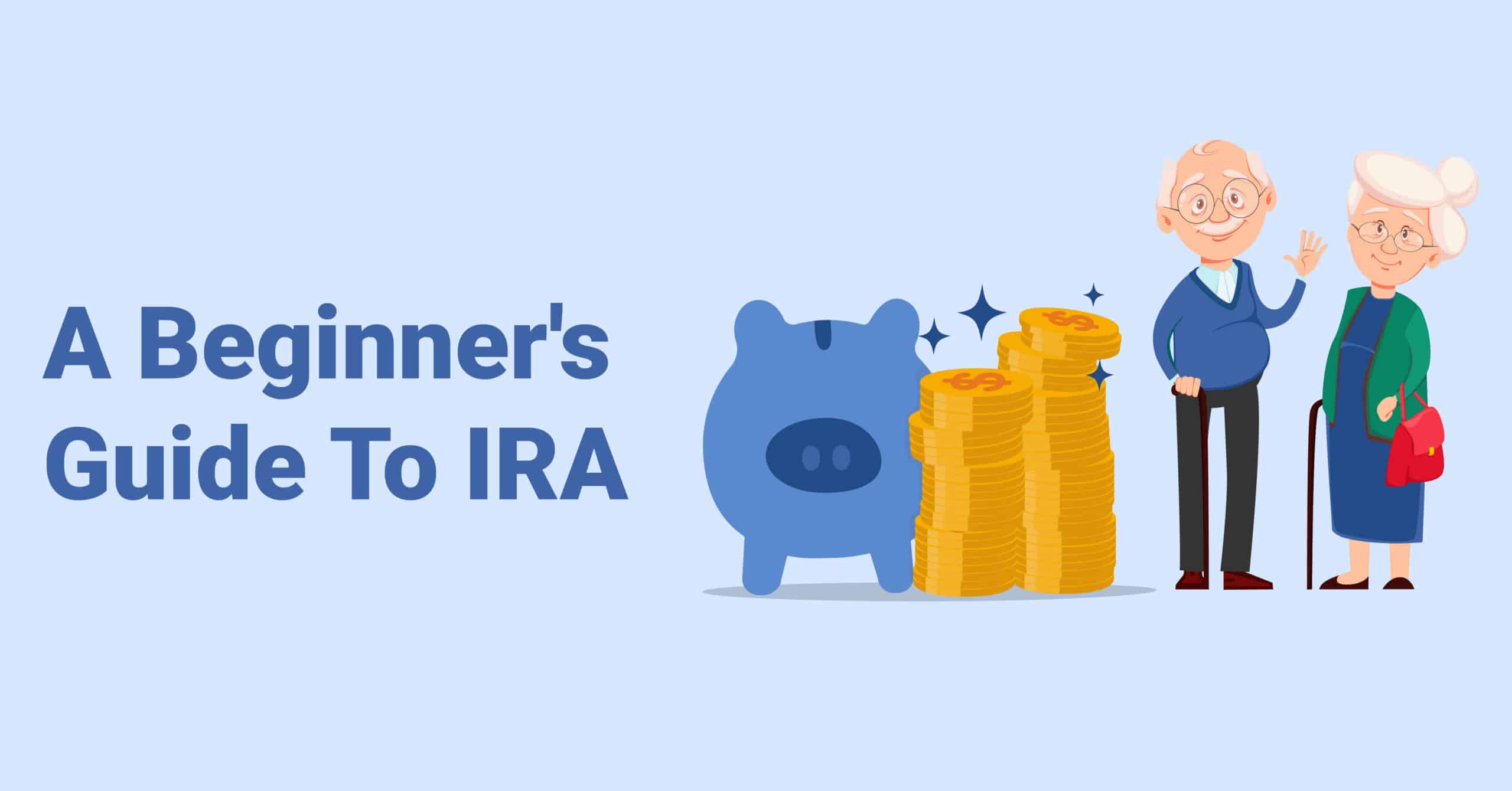The term “IRA” has been thrown around a lot in recent years. It’s an account that every adult should have, but many still don’t truly understand.

If you are one of the millions scratching their heads, confused about what this all means, don’t worry. We are going to explain everything to you in easy-to-follow terms.
We will explain what an IRA is, how they work, the types you can get, the benefits you will receive, and how to invest.
We want to make everything as simple as possible for you so when you’ve finished reading this article, you are no longer confused.
Table of contents
What Is An IRA?

IRA stands for Individual Retirement Account or Individual Retirement Arrangement. It is a tax-deferred investment account designed to help you save for retirement.
Tax-deferred means you won’t be taxed for the money saved into this account.
There are four main types of Individual Retirement Accounts, and we will go into more detail about them later. For now, we will simply give their names. These popular IRAs are Traditional IRA, Roth IRA, SEP IRA, and SIMPLE IRA.
Each of these offers savings rewards and tax benefits, but they also offer different perks to each other. Again, we will discuss this in more detail later, but if you see the word Roth you now know that the lender is talking about an IRA.
Individual Retirement Accounts can be opened with banks, brokers, financial advisors, and more.
Your deposits into these accounts are tax-deductible. This means that if you earn $50,000 annually, but put $1,000 into an IRA, then you will only be taxed for $49,000 that year.
Withdrawals are sometimes tax-free as well. However, this usually comes with a condition. Many IRAs only allow you to make a withdrawal earlier than your retirement age, however you may receive a penalty for the privilege. This changes from bank to bank, though.
How Do IRAs Work?

The idea behind Individual Retirement Accounts is to compound your money. Compounding has a two-step process.
First, you need to put your money into an account that gives interest. Then you leave this account alone, not withdrawing from the sum. As your account slowly gathers interest, the total sum will get larger.
Accounts with compounding interest will look at the total amount in your account and calculate your interest based on that figure – not a flat sum. The larger the fund gets, the more interest you receive. The effect is called compounding interest.
However, there is more than one way to use your IRA. It is also an investment account. This means you can put your money into bonds, stocks, or any other asset you want to. Your investment could make the interest grow larger again. The more you invest, the more you get out of the IRA.
But it isn’t all interest and growth. If you put money into the stock market and your stocks fail, you could lose this money. Depending on how close you are to retirement, you may prefer to take a less risky route and invest in something like a house.
A house should constantly grow in value, and unless it gets hit by a natural disaster, it should hold firm until retirement. That being said, you cannot use the money locked into your house until you sell it on. If you want this money available to you, an IRA would be a more liquid investment.
Although you can take money out of your Individual Retirement Account, you will be penalized if this is done before your agreed retirement age. The most common penalty is a charge of 10% payment for the withdrawn value.
This means that although you can take the money out of the account, you should avoid it at all costs. Instead, you should try and let the sum grow.
Unfortunately, IRAs cannot grow and grow without a limit. Each year there is a contribution cap. This means that your bank will set the maximum amount you can deposit. This contribution limit will be dependent on the bank and your wages.
The Four Types Of IRAs

We have briefly talked about the four most common types of Individual Retirement Accounts, but now we want to go into more detail. This should give you a better understanding of the difference, to help you decide which is best for you.
Traditional IRA
The traditional IRA is also the simplest. As you can expect, it was the first type to be created, and the most commonly used.
Traditional IRAs are tax-deductible. As we explained earlier, this means that whatever you pay into the account will not be taxed from your annual taxable income. However, the money you withdraw from traditional IRAs is taxable.
For example, if you earn $50,000 annually and pay $1,000 into your IRA, you can expect to be taxed for $49,000 of your income. However, if you remove $500 from your IRA in the same year, you will be taxed for $49,500 of your income.
If you are under 50, you can contribute a maximum of $6,000 annually. If you are 50 or over, you can contribute a maximum of $70,000.
For spouses who have a retirement plan agreed with their workplace, the amount you can contribute is reduced again. It doesn’t matter which of the spouses has this agreement with their employer.
When the married couple reaches a certain income, their contribution allowance is reduced to $0.
If you don’t have a retirement plan with your employer, then it doesn’t matter how much you earn; only the normal contribution maximum will apply.
You can go over your contribution allowance, however, these extra payments will be taxed.
You can generally start taking money from traditional IRAs when you reach the age of 53. If you make a withdrawal before this age, you will pay a 10% penalty. That being said, there are exceptions to this rule, depending on the bank.
When you reach age 72, you can start withdrawing money without penalty. However, failing to withdraw will bring fines.
Roth IRA
Roth IRAs work very similarly to traditional IRAs; however, the main difference is around how the tax works.
Your contributions are tax-deductible with traditional IRAs, but your withdrawals are taxable.
The opposite is true for Roth IRAs.
Your contributions are taxed with a Roth IRA, but your withdrawals are tax-free. There are also no taxes placed on your investment gains.
Because of this swap in taxation, Roth IRAs are the best option for those starting their retirement fund early. You can pay in a small amount of money every month, and although it will be taxed, the early start means the compounding effect will have more time to grow.
When retirement comes, you’ll then be able to withdraw your money without being taxed. You can pay more now and less later. If you start this process early, the compound interest would be worth the upfront investment. Think of it with this metaphor – would you rather pay taxes on a seed or on the harvest of that seed?
You can contribute a maximum of $6,000 if you are under 50 or $7,000 if you are 50 or over. This is the same as traditional IRA.
If you are single and earn $144,000 or more annually, you cannot make a contribution. If you are married and have a joint income of $214,000 or more, you cannot make a contribution.
As a fun fact, we want to share why Roth IRAs are called “Roth.” They are named after Senator William Roth from Delaware. Senator Roth championed the need for tax-free withdrawals and sponsored the legislation to create it. In 1998, the IRA was created in his name.
SEP IRA
SEP stands for Simplified Employee Pension. They are similar to traditional IRAs, but instead, they are aimed at self-employed individuals or owners of small businesses.
Just like traditional IRAs, simplified employee pension IRAs have tax-deductible contributions, meaning you won’t be taxed on the money entered into the IRA. When your compound interest grows, this will be tax-deferred too.
Instead, you will be taxed when you start using the SEP as your income.
You can contribute more to a SEP than you can to the traditional IRA, but that’s because this system is aimed at businesses. You are allowed to contribute either 25% of your compensation or $61,000 – whichever is less.
This has grown since 2021, which was either 25% or $58,000. However, once you are over the age of 50, you cannot add more contributions to the SEP.
At age 72, you are required to start taking minimum withdrawals from your SEP. You can start taking out the pension at the age of 50 if you want to, but by 72, you cannot let the money sit any longer.
There are more restrictions on a SEP than the other IRAs we have talked about already. The first is that you cannot have a SEP if you already have a retirement account set up. This is true even if you don’t make contributions to this original retirement account.
You must also either pay your employees or get paid at least $650 annually.
SIMPLE IRA
SIMPLE is another Individual Retirement Account for businesses. Specifically, they are designed for businesses with less than 100 employees. The name SIMPLE is an acronym that spells out Savings Incentive Match Plan for Employees.
Just like with traditional IRAs, the contributions to the fund are tax-deductible. The interest and investment will grow as the years go on, but the withdrawals will become taxed when the employee reaches retirement age.
This is because the distributions will be classed as income.
An employee can deposit up to $14,000 per year as long as they are under 50. If they are 50 or older, the contributions are massively restricted. Instead, they can only deposit up to $3,000.
Many employers prefer to set up a SIMPLE IRA because, as the acronym suggests, it is simple. At least, the process is more straightforward than a 401(k). However, the price of simplicity comes at the cost of contribution limits.
401(k)s allow you to contribute either 100% of your yearly pay or $19,000, whichever is less.
The benefit of a SIMPLE IRA is that the employer must make a contribution to the employee’s account.
But IRAs have more advantages that we should dive into.
The Benefits Of An IRA

Hopefully, you can already see the benefits of an IRA from the descriptions above, but we want to go into more details about why an IRA is a fantastic option for you.
You might already have 401(k), but that doesn’t mean you can’t invest in other retirement options too.
No matter which IRA you want to add to your collection of retirement investments, they all have their own benefits.
IRAs Are Easy To Set Up And Available To Most
IRAs are designed to make retirement easier. This means that every step of the process should be simple.
To be eligible for an IRA, you simply need to have a taxable income. In fact, if your partner has a taxable income, then you don’t need one. As long as you, or your spouse, is earning money, you are eligible for an IRA.
You might think that your age would factor into this retirement plan, but it doesn’t. You can be two years away from retirement or taking your first steps in the working world. Either way, age isn’t a factor.
The only thing getting in your way when it comes to age is the amount in which you can contribute. As we have shown above, each IRA has a different restriction, but on average, when you hit the age of 50, the amount you can contribute starts to decrease.
The second thing that might limit your contribution is your tax filing status. Again, this doesn’t mean you cannot get an IRA at all, but you might be limited on how much you can contribute. Other retirement plans might prevent you from contributing if you earn over a certain amount, but IRA just limits the figures.
Accessibility comes in more forms than eligibility, though. It also refers to how you physically apply. IRAs can be opened through most banks. You can apply for them online or in-person; either way, they tend to take a couple of minutes to set up, and hey presto, you are good to go!
Going to a bank often means you can ask a professional to help you make your investments; to some, this is a blessing; to others, this is a waste of time. IRAs, however, allow you to choose.
Again this opens up your route to accessibility, as you can manage your investments by yourself if you so desire. You can even opt for an automated strategy to keep on top of your assets for you.
Cut Tax Bill
Every type of IRA offers some kind of tax break. This is because you will be using this money twice in your lifetime. The first time is when you put in the fund and the second is when you take it out. To make sure you don’t get taxed twice for something you desperately need, you are instead only taxed once.
Depending on which IRA you pick, you can decide to have your contribution as tax-exempt and then pay tax like an income when you receive your monthly payments for retirement. Or you can pay tax now (while it is cheaper) and pay no taxes when you are retired.
The best financial option would be to take the tax now, as it’s cheaper due to the low starting amount. It also means that you don’t need to worry about how much money goes to the government when you retire.
However, if you’re low on money now, you may need to focus on taking a tax cut instead. This will delay the tax on the retirement fund until you withdraw the IRA. You will be able to pay more, and therefore the compound interest will grow due to this additional money.
However, when you hit the age of 72, that’s when you have to start taking withdrawals or distributions. You cannot let the money sit in the pot forever.
If you decide to take the tax break at the “pay in” stage, then you have to pay tax when you take it out. If you paid tax when you paid in, then you will have your tax break during your retirement.
A Tax Break During Retirement
We have already discussed the concept of a tax break during retirement, but this is such a unique scheme that we need to expand a bit more. It is the Roth IRA that offers this switch up; allowing you to pay the taxes now and be free of tax when you retire.
If you start saving in your 20s or 30s, this can be a massive advantage. That’s because you will be less likely to have significant commitments yet, as children might not be on the cards, and your parents may not be old enough to require your constant financial support.
Starting up financial security at this age means you can afford to make those extra tax payments. Although you will be putting less money in the pot, you’ll be adding contributions over time. This means the lower payment will be counteracted by making contributions more often. And your pool will continue to grow due to the compounding interest.
It’s these flexible options that the IRAs give which are so beneficial. Because there is no tax to pay when you take the money out of the Roth IRA, you can make withdrawals whenever you want.
You could retire early and not worry about the cost of early withdrawals.
You Own Your IRA
According to the Bureau of Labor Statistics, just 61% of US citizens actually have access to their employer monitored retirement fund (2021). The majority of these funds were 401(k)s.
Unlike 401(k)s, IRAs give the owner of the retirement fund the power. Usually, an employer will be the one to decide what happens to your 401(k); they can change up your investment style, limit your payments, make you pay more, or anything else. They can do all of this without talking to you too.
And worst of all, if you were to leave the job, you would no longer be able to contribute to that 401(k).
IRAs are different. They are yours to do with as you choose. Switching jobs doesn’t affect the fund, and you can control which investments to pick and how much you contribute.
You can still talk to professionals about how you want your IRA managed, so if you don’t know a lot about stocks, bonds, and other investments, you won’t be left alone.
Once a professional has explained how these investments work, you can add them to your investment portfolio, showing that your financial profile is more adaptable and controlled than before.
Saving Money For Retirement
Of course, the whole reason why we are looking into investing for retirement is because we cannot work throughout our lives. Eventually, our bodies and minds can no longer handle the pressure of work life.
As your mind and body become more fragile, you need a cushion of money to protect you from financial burdens.
However, retirement isn’t all about protecting yourself when you’re frail. A good retirement plan means you can leave the working world behind while you are still fit and healthy.
Many IRAs allow you to start making money from the pot as early as 50 years old. That is half of most people’s lives. Of course, depending on when you started this journey, you may not have enough money to retire at 50. Remember, you need that pot to carry you into your waning years.
However, if you start saving at the age of 20, you could retire while you still have half your life ahead of you.
How To Invest In IRAs

So now you know the information surrounding IRAs, it’s time to help you navigate the mechanics. Today, we will explain how much you can and should be investing into your IRA, how to pick the right investment for you, and how to actually open an IRA account.
How Much Can I Invest?
Each year the amount you are allowed to invest into an IRA changes. This is due to the growing inflation that naturally occurs.
The different types of IRA will also limit how much you are allowed to invest.
So let’s break down the amounts you can invest.
How Much Can I Invest In A Traditional IRA?
You can invest up to $6,000 annually if you are under 50. Or you can invest $7,000 annually if you are 50 or over.
If you are a single person household and earn $68,000 or less, your contribution will be tax-deductible. If you earn between $68,000 and $78,000 annually, it will be partly tax-deductible. If you make $78,000 or more annually, it is not tax-deductible.
If you are married and are filling your IRA as a couple, this figure changes. If you earn $109,000 annually as a couple, your investment is tax-deductible. If you earn between $105,000 and $125,000, your investment is partially tax-deductible. If you make more than $125,000 as a couple, then your investment is not tax-deductible.
How Much Can I Invest In A Roth IRA?
You can invest up to $6,000 annually if you are under 50. Or you can invest $7,000 annually if you are 50 or over.
However, this information is different depending on how much you currently earn.
If you are a single person household and earn $125,00 or less, you can contribute up to $6,000 annually ($7,000 if you are 50 or older). If you make between $129,000 and $144,000 annually, it will be reduced depending on the bank used. If you earn $144,000 or more annually, you cannot make any more contributions.
If you are married and are filling your IRA as a couple, this figure changes. If you earn $204,000 annually as a couple, you can contribute up to $6,000 annually ($7,000 if you are 50 or older). If you earn between $204,000 and $214,000, it will be reduced depending on the bank used. If you earn more than $214,000 as a couple, you cannot make any more contributions.
How Much Can I Invest In A SEP IRA?
SEP is more straightforward than the other two IRAs we have already mentioned.
You can contribute either 25% of your pay or $61,000 – whichever is less.
When you reach the age of 50, you can no longer make contributions.
How Much Can I Invest In A SIMPLE IRA?
SIMPLE IRAs are also straightforward. You can contribute up to $14,000 annually until you hit the age of 50. When you are 50 or over, you can contribute up to $3,000 annually.
How Do I Pick Investments?

When you use a 401(k), you will be offered a drop-down list of investment options. This makes the process easy, but you don’t have a lot of choices.
IRAs allow you to pick your own investments. This means you have a lot of flexibility, but you need to do a little more work. You could hire a professional to manage this for you.
If you want to do it yourself, you should consider these options. For stocks, check out Yahoo Finance, and for bonds, you should look into Forbes.
A professional would be the best person to talk to about your goals, your financial situation, and the risks you are willing to take.
How Do I Open One?
Although you might expect a retirement fund to go through the government or your employer, an IRA more closely resembles a savings account.
You simply need to go to a bank’s website, give them a call, or go into one of their branches to ask for an IRA. Of course, you should research the best IRAs for your goals, but once you have found the right one, you just need to fill in some forms, and away you go.
The forms will include typical banking questions such as your social security number, name, date of birth, address, salary, and more.
If you are moving from one retirement fund to a different one, then the bank will also ask for your previous account information. This is so the money gets transferred over, and nothing goes missing.
Depending on the bank, you may have to contribute a big starting fund to start investing. The most common recommended size is $2,500; however, you can get IRAs for as little as $100.
The process might seem complicated due to the information you need to get before setting up, but remember that dedicated professionals are ready and willing to make the investing suggestions for you. Unlike with a 401(k), the professional cannot change your investment without your permission, so you will still be in control even if you need help.
Summary

Taking hold of your finances is the best way to protect yourself in your golden years. The earlier you set up these retirement plans, the better off you will be.
Now you’ve read our article, you know that an IRA is more beneficial than the classic 401(k). You can also have both at the same time.
It’s the compounding interest that makes this type of retirement fund possible, so the earlier you put the money into a fund, the better.
You also have the choice of paying tax now, when the payments will be cheaper, or later like a normal income. With all of this information, you can start your journey to financial security in your retirement.
